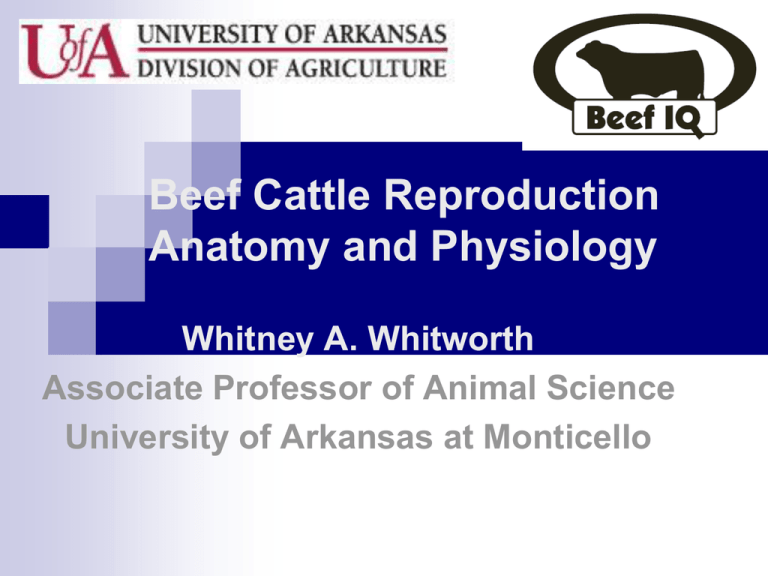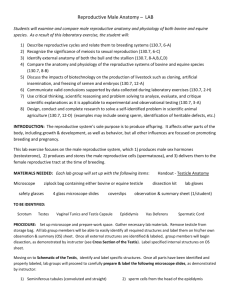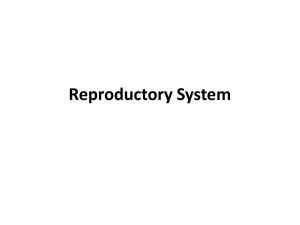Animal Reproduction
advertisement

Beef Cattle Reproduction Anatomy and Physiology Whitney A. Whitworth Associate Professor of Animal Science University of Arkansas at Monticello Improve reproductive efficiency Production of young is primary determinant of income for most livestock species A 3% improvement in birth rate would result in an additional 1 million beef calves per year Introduction Reproduction is a tremendously coordinated process, mainly between anatomy and endocrine functions Basis for reproduction is the gonad Female: ovary Male: testis Puberty Transitional state after which animals are able to reproduce Most important signals are weight and age Nutritional stress and season of year are also important After puberty, an animal is said to be reproductively competent Puberty Associated with development of secondary sex characteristics Hump on necks in males, increased musculature, voice changes Addition of body fat in females, mammary development Endocrinology Endocrine cues are initiated by the hypothalamus Small area in brain which releases GnRH Released in an episodic manner, travels to the anterior pituitary gland Anterior pituitary gland releases LH and FSH Travel to the gonads of both males and females Relationship between hypothalamus and pituitary gland Bearden and Fuquay, 2000 Endocrinology LH: Luteinizing hormone Induces ovulation & development of the corpus luteum Aids in the maturation of the follicle and spermatozoa Stimulates testosterone production in the male FSH: Follicle stimulating hormone Induces follicular development Induces estrogen production Stimulates spermatogenesis Endocrinology After ovulation, follicle turns into corpus luteum (CL) Primary function is progesterone production Required for maintenance of pregnancy Progesterone inhibits FSH and LH production Reduced excitability of smooth muscle fibers Negative feedback to the hypothalamus Endocrinology Estrogen: This follicular hormone is responsible for: Estrus Influence mobility and secretory function in the reproductive tract Responsible for early stage development of the mammary gland Follicles produce estrogen, causing an LH surge LH surge causes ovulation Endocrinology Oxytocin: secreted by the posterior pituitary and the corpus luteum causes contractions of smooth muscle fibers. This is involved in: Milk “let down” Uterine contractions during parturition Contractions of smooth muscle in uterus and oviducts during mating Prostaglandin: Produced by the endometrium of the nonpregnant uterus. Causes the regression of the corpus luteum Causes uterine contraction Female Anatomy Consists of ovaries, oviducts, uterus, cervix, vagina, and external genitalia Suspended below the rectum by various ligaments Ovaries: Responsible for storage, development, and release of ova Produce progesterone and estrogen Female Anatomy Ovaries Contain all of the ova (eggs) the female will ever have in her life Ova develop into follicles during the monthly estrous cycle of the female Follicles either continue to grow or undergo atresia Upon ovulation, follicle is captured by the infundibulum Directs ovum to oviduct, sight of fertilization being the ampullary-isthmic junction Female Anatomy Oviduct is connected to the uterus Ovum will reside in oviduct for approx. 3-6 days before traveling into uterus Cattle have bipartite uterus Short uterine horns, small uterine body Uterine function to provide passageway for sperm, protect fetus, and expel fetus during parturition Female Anatomy Cervix has following functions: 1. 2. 3. 4. Passageway for sperm cells Storage reservoir for sperm cells Barrier between external and internal environments Provide lubrication 5. Passageway for fetus during parturition Under influence of high progesterone, cervix is closed off Female Anatomy Vagina Serves as copulatory organ is most species Connects cervix with vulva Uterine Body Uterine Horn Ovary Oviduct Cervix Vagina Blind pocket Bladder Urethra Clitoris Vulvo-vaginal sphincter muscle Vestibule Labia Majora Rectum Uterus Ovary Vulva Vagina Pelvis Cervix Broad Ligament Bladder Oviduct Male Anatomy Primary structures of the male reproductive tract are: Testis Penis Duct system Accessory sex glands Male Anatomy Testis – responsible for both sperm production and sex steroid production For sperm production, scrotum must be 4-6 degrees below body temp. If one or more testicles do not properly descend into scrotum, cryptorchidism is result Have secondary sex characteristics, but usually no sperm production Male Anatomy Testes are suspended by the spermatic cord into the scrotum Scrotum contains thermosensors Can induce sweating Cause increased respiration rate Cremaster muscle can raise or lower testes, with aid of tunica dartos muscle Also contains a special vascular system called the pampiniform plexus Male Anatomy Both sperm and testosterone made in the testis Tremendous potential for gamete production in the male Produced in the seminiferous tubules, migrate to epididymis Three functions of epididymis: storage, transport, and maturation Male Anatomy Prior to ejaculation, sperm travel from the epididymis through the ductus deferens to urethra Ductus deferens can be cut in procedure called vasectomy Accessory sex glands produce fluids which are added to sperm to make semen Three glands are: the vesicular glands, the prostate gland, and the bulbourethral glands Male Anatomy Penis is organ which deposits semen into the female (either vagina or cervix depending on species) Farm animal species either have a vascular (stallion) or fibroelastic (bulls, boars, rams) penis Fibroelastic penis exists in S-shape within the body of the male until erection When erection takes place, muscles relax and allow penis to extend outside the body Cowpers Gland Rectum Prostate Seminal Vesicles Ampulla Bladder Sigmoid Flexure Retractor Penis Muscle Glans Penis Scrotum Testis Vas Deferens Caput Epididymis Cauda Epididymis Spermatic Cord - Caput Epididymis Vas Deferens Tunica Albuginea Corpus Epididymis Rete Testis Cauda Epididymis Blood supply in testis aids in cooling 1. Pampiniform Plexus Counter-current heat exchange causes a cooling of arterial blood supply Single artery surrounded by a network of veins (Increased surface area) 2. Convoluted testicular artery on surface of the testis In Ram temperature decrease 40C before entering testis Scrotum, testis and spermatic cord are all involved in thermoregulation Pampiniform Plexus Testicular Artery Pregnancy Successful timing of ovulation and mating should result in pregnancy Female is receptive to male during estrus, encouraging copulation Window of opportunity for fertilization is narrow If has not occurred within 12 hours of ovulation, ova begins to degenerate Pregnancy Fertilized oocyte is called a zygote Cell division begins soon after fertilization Stages: zygote morula blastocyst Blastocyst is free-floating and moves down oviduct to uterus Day of implantation occurs between days 18 and 22 Inner cell mass of blastocyst becomes fetus and trophoblast becomes placenta Pregnancy High levels of progesterone are required for pregnancy Pregnancy must be recognized by female to prevent degradation of the CL Maternal recognition of pregnancy signals: Cow and sheep = IFN- Pregnancy Trophoblastic cells give rise to placenta Fetal membranes include the amnion, chorion, allantois, and the yolk sac Placenta regulates exchange of oxygen, nutrients, waste, and in some cases, antibodies When more than one fetus is present, the fetal membrane fuse together If bovine twins are of differing genders (one male and one female), female will be sterile Condition is called Freemartinism Pregnancy Approximately 2/3 of fetal growth occurs in the last trimester Energy demands are the highest during this time Pregnancy averages 283 days in beef cattle Parturition Process of giving birth Initiated by hormone secretions of the fetus Caused by fetal stress Parturition Most births occur naturally with no assistance Malpresentations and inappropriate size of offspring may necessitate intervention Dystocia = difficult birth Major cause of dystocia is size of fetus Parturition Females preparing to give birth demonstrate behavioral changes Become restless, separate from others, show discomfort Udder becomes engorged, vulva begins to swell Parturition Birth occurs in three stages: Stage I = initiation of myometrial contractions Stage II = expulsion of fetus Must be completed in a timely manner Stage III = expulsion of placenta May take up to several days Parturition Following birth, most animals clean their young and bond with them Critical for young to eat ASAP so that they get colostrum Contains maternal antibodies and is responsible for first immunity Greatly increases rate of survival of offspring Parturition Interval between parturition and onset of estrus activity is called postpartum or postpartum interval Cattle must become pregnant within 80 d after birth to ensure a yearly calving interval Greatly affected by poor nutrition, and presence of suckling offspring Environmental Influences on Reproduction Nutritional effect can influence female’s ability to get pregnant and male’s ability to exhibit libido Primary nutritional limitation on animals is energy Female loses ability to become pregnant as she loses body fat Also, if a female is too fat she may fail to conceive






